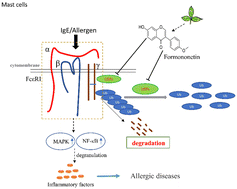Natural isoflavone formononetin inhibits IgE-mediated mast cell activation and allergic inflammation by increasing IgE receptor degradation†
Abstract
Immunoglobulin (Ig)E-associated mast cell (MC) activation triggers pro-inflammatory signals that underlie type I allergic diseases. Here, we examined the effects of the natural isoflavone formononetin (FNT) on IgE-mediated MC activation and associated mechanisms of high-affinity IgE receptor (FcεRI) signal inhibition. The effects of FNT on the mRNA expression of inflammatory factors, release of histamine and β-hexosaminidase (β-hex), and expression of signaling proteins and ubiquitin (Ub)-specific proteases (USPs) were analyzed in two sensitized/stimulated MC lines. FcεRIγ–USP interactions were detected by co-immunoprecipitation (IP). FNT dose-dependently inhibited β-hex activity, histamine release, and inflammatory cytokine expression in FcεRI-activated MCs. FNT suppressed IgE-induced NF-κB and MAPK activity in MCs. The oral administration of FNT attenuated passive cutaneous anaphylaxis (PCA) reactions and ovalbumin (OVA)-induced active systemic anaphylaxis (ASA) reactions in mice. FNT reduced the FcεRIγ chain expression, via increased proteasome-mediated degradation, and induced FcεRIγ ubiquitination by inhibiting USP5 and/or USP13. FNT and USP inhibition may be useful for suppressing IgE-mediated allergic diseases.



 Please wait while we load your content...
Please wait while we load your content...